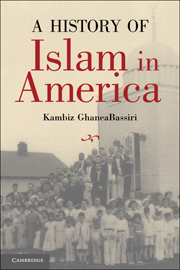Book contents
- Frontmatter
- Contents
- List of Illustrations
- Acknowledgments
- Introduction
- 1 Islam in the “New World”
- 2 Islamic Beliefs and Practice in Colonial and Antebellum America
- 3 Conflating Race, Religion, and Progress
- 4 Race, Ethnicity, Religion, and Citizenship
- 5 Rooting Islam in America
- 6 Islam and American Civil Religion in the Aftermath of World War II
- 7 A New Religious America and a Post-Colonial Muslim World
- 8 Between Experience and Politics
- Epilogue
- Select Bibliography
- Index
3 - Conflating Race, Religion, and Progress
Social Change, National Identity, and Islam in the Post–Civil War Era
Published online by Cambridge University Press: 05 August 2012
- Frontmatter
- Contents
- List of Illustrations
- Acknowledgments
- Introduction
- 1 Islam in the “New World”
- 2 Islamic Beliefs and Practice in Colonial and Antebellum America
- 3 Conflating Race, Religion, and Progress
- 4 Race, Ethnicity, Religion, and Citizenship
- 5 Rooting Islam in America
- 6 Islam and American Civil Religion in the Aftermath of World War II
- 7 A New Religious America and a Post-Colonial Muslim World
- 8 Between Experience and Politics
- Epilogue
- Select Bibliography
- Index
Summary
We are all a little wild here with numberless projects of social reform; not a reading man but has a draft of a new community in his waistcoat pocket.
Ralph Waldo Emerson (1840)The poly-religious common ground African Muslims sought with white Christians and non-Muslim Africans, though distinctive, was symptomatic of the times. Emerson's description of religious life in America in a letter to the historian and essayist Thomas Carlyle (1795-1881) captured the experimentalist, adaptive, heterogeneous, spiritualist, and individualistic ethos of religious life in antebellum America. The religious issues facing African Muslims were unique in many ways because of slavery and institutionalized racism, but as Nicholas Said's embrace of the teachings of the scientist, mystic, philosopher, exegete, and visionary Emanuel Swedenborg reminds us, not all African Muslims were cut off from the socio-religious reform movements to which Emerson referred. Americans sought to adapt their religious lives to Enlightenment ideals and the founding principles of their new republic, and they were not wanting in prophets, visionaries, fraternities, or volunteer associations. Mormons, Shakers, Evangelicals, Theosophists, Transcendentalists, Freemasons, Adventists, and Millenarians (just to name a few) all offered their own interpretations of religion and communal life.
The rapid growth of immigration to the United States in the latter half of the nineteenth century further altered America's religious landscape. In 1775, Catholics numbered about 25,000. By 1860, an estimated 3 million Catholics lived in the United States, and by 1900 their number rose to 12 million.
- Type
- Chapter
- Information
- A History of Islam in AmericaFrom the New World to the New World Order, pp. 95 - 134Publisher: Cambridge University PressPrint publication year: 2010

